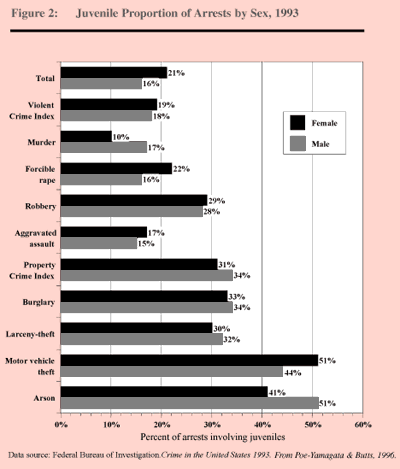Why Address Their Needs Now?
For too long, delinquent girls have been punished for being victims, for not being boys (and, as a result, not melding into existing programs), and for being misunderstood because girls' development does not mirror that of boys.
Over the last decade, an increasing number of juvenile justice agencies and systems have begun to look at the needs of girls separate from those of boys. A research base now exists that describes how girls develop, what they need, who they are, and what risks they face because of gender. Taking this information, gleaned primarily from the educational and mental health arenas, juvenile justice practitioners have developed principles of gender-specific programming and "best practices" for working with girls. The Office of Juvenile Justice and Delinquency Prevention has supported planning grants and technical assistance to implement gender-specific programming in a variety of agencies and jurisdictions.
Like female juvenile delinquents, women who commit crimes have been an invisible minority whose needs, histories, and issues have gone largely undocumented (Belknap, 1996). Women offenders account for only about 6 to 8 percent of the U.S. prison population, a number many researchers have considered too small or insignificant to warrant in-depth study. However, a recent increase in the female crime rate is drawing more attention to this population, just as increases in arrests of juvenile females are drawing attention to young female offenders.
The emerging profile of women offenders bears strong resemblance to the profile of female delinquents, with many of the same risk factors impacting women's and girls' lives. More than four in 10 female adult inmates report a history of physical or sexual abuse. Nearly six in 10 grew up in a household with at least one parent absent. Minorities are disproportionately represented among the adult female offender population. Women prisoners are likely to be poor, undereducated, and single parents. About 20 percent of adult female offenders also served a sentence as a juvenile (Snell, 1994; Belknap, 1996). (See Figure 2)

Although research on the causes of criminal behavior in women remains scarce, many women currently serving sentences report that they can see a link between their adult offense and their history of sexual victimization, drug abuse, and prostitution (Belknap, 1996). For many of the women currently housed in prisons, these issues have gone unaddressed and untreated since childhood.
Gender equity in juvenile justice programming is an important focus of the Juvenile Justice and Delinquency Prevention Act, reauthorized in 1992. Under the Act, states may receive challenge grants for "developing and adopting policies to prohibit gender bias in placement and treatment of young offenders," and for "establishing programs to ensure that female youth have access to the full range of health and mental health services, treatment for physical or sexual assault and abuse, self-defense instruction, education in parenting, education in general, and other training and vocational services." (Juvenile Justice and Delinquency Prevention Act, 1992)
The needs of females in the juvenile justice system have not kept pace with societal changes in the roles and goals of women. While women have made great strides, for instance, in the educational, political, and occupational spheres, breaking into professional and technical fields once dominated by men, many programs for young females reflect an earlier era, training girls for lower-paying, low-skill jobs. In reauthorizing the Act, lawmakers have attempted to address these discrepancies. The Act encourages states to empower young women to defend themselves, assert their rights, overcome abuse, aspire to rewarding and lucrative careers, and lead healthy, independent lives.
The reasons to focus on girls' issues are compelling, especially as the number of females involved in the justice system continues to grow. Researchers have achieved an increased understanding of the developmental pathways that may be leading girls to delinquency. Practitioners have a better knowledge of the best practices for working with girls in the juvenile justice system. The combination of these factors makes the timing appropriate to focus specifically on the needs of the girls of today, who will become the women of tomorrow.
| Guiding Principles for Promising Female Programming |
|